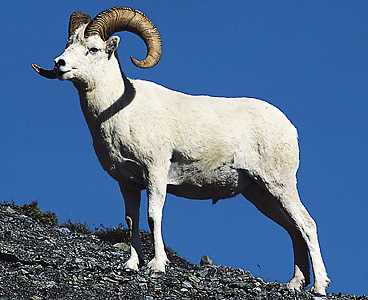Bighorn is a kind of wild sheep found only in North America. Male bighorn sheep have massive horns that curve backward from the forehead, down, and then forward. The horns may measure more than 4 feet 2 inches (1.3 meters) long, with a circumference of up to about 17 inches (43 centimeters) at the base. Female bighorns have very short horns that are only slightly curved.

Bighorns are also called mountain sheep. They live in mountains from east-central British Columbia in Canada to Baja California in northwestern Mexico. Bighorns that inhabit the slopes of the Rocky Mountains and Sierra Nevada are dark grayish-brown in color. Those that live farther south in the mountains of the desert have coats of pale buff. All bighorns have patches of creamy-white fur on their rumps.
The size of bighorns varies, depending on their sex and the regions in which they live. The rams (males) generally are much larger than the ewes (females). In the northern mountains, bighorn rams may stand up to 31/2 feet (107 centimeters) high at the shoulder and may weigh up to 300 pounds (140 kilograms). Ewes in this region typically weigh less than 160 pounds (73 kilograms). In the desert mountains, rams rarely weigh more than 200 pounds (90 kilograms) and most ewes weigh less than 120 pounds (54 kilograms).
Male bighorns usually live in groups of 2 to 15 animals. Females and young live in separate groups, usually of 5 to 30 animals. During the mating season, rams often engage in long, spectacular fights. In these battles, which may last for hours, two or more rams repeatedly charge at one another and fiercely crash their horns together. Typically, the male with the largest horns wins.
Loading the player...Rams fighting
Ewes bear one lamb about 175 days after mating. Male bighorns reach maturity at about 7 to 8 years of age. Females mature at about age 4.
Bighorns feed on grasses and low shrubs. Their chief enemies include wolves, coyotes, and mountain lions. Bighorns also are endangered by diseases of livestock and by the spread of industrial developments, which have destroyed much of the animal’s habitat.
Another species of North American wild sheep, called Dall’s sheep or thinhorn, is closely related to the bighorn. Dall’s sheep are smaller than bighorns and have more slender horns. They live in Alaska, British Columbia, and Yukon. They range in color from white in the northernmost part of their range to black in the southernmost part. Dark brown or black Dall’s sheep are also called Stone’s sheep.

